
7 minute read
Walking the Camino Two friends share a journey across Spain
Story by Susan Thacker sthacker@gbtribune.com
he journey of over 900 miles starts with two friends each taking a single step.
In this case, the friends are Glenna Achatz and June Sexson Price, on separate but related treks across Spain. They followed different paths to complete the walk known as the Camino de Santiago.
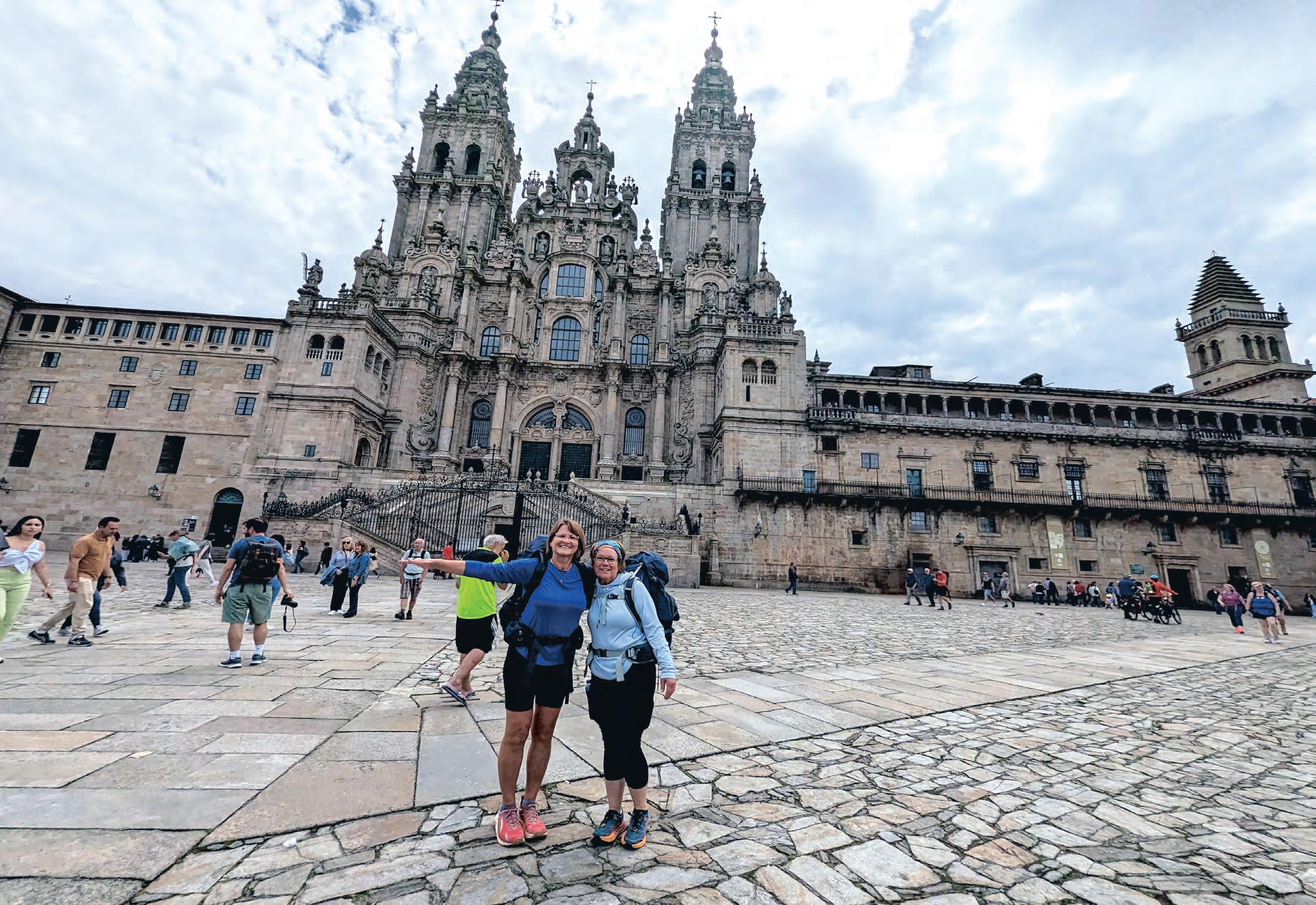
Price bypassed a final mountain hike, completing a trek of about 410 miles. Achatz went out on her own for that part of the trip, making her walk about 500 miles.
Price made this journey on her own five years ago, shortly after retiring from her job at the Kansas Lottery Office at age 62. When she returned, some of her classmates from the Great Bend High School Class of 1974 expressed interest in joining her for a repeat trip. As fate would have it, only Achatz, part owner of Coldwell Banker Sell Real Estate in Great Bend, was able to join her this past spring.
About The Walk
Also known as the Way of St. James, the Camino began as a medieval pilgrimage that in modern times has become both a physical hiking challenge and a personal spiritual journey. Today’s pilgrims can follow a network of connected hiking trails that are clearly marked with yellow arrows. There are several routes that all lead to the cathedral of St. James in Santiago de Compostela, Spain.
More than 347,000 people from all over the world walked these trails to completion in 2019, according to statistics from the Pilgrim’s Reception Office. Price heard the number had reached 400,000 in 2022 and the numbers are up this year, even before the busy season in July. Those who walk the last 100 kilometers of the pilgrimage to the tomb of St. James on foot can receive a Compostela, a document of accreditation awarded by the church authorities. As they visit cathedrals and other places they pass through, or check into a room for the night, they receive stamps of verification on a Camino passport that serves as their credentials.
Staying On The Path
With numerous pilgrims on the trail and yellow arrows to mark the way, it is hard to get lost. Price repeated a piece of advice she’d learned on her first walk:
“If you have not seen a yellow arrow for a while, stop,” she said. Wait until you see another pilgrim, or turn around and walk back to where you see an arrow, so you don’t get lost.
Because of its growing popularity, visitors such as Achatz and Price were often in contact with other walkers, which was helpful if they missed a marker and needed to get back on track. But it also meant some days the Spanish hostels, called albergues, filled to capacity.
“There was what we called a race for the beds,” Price said.
The Camino is considered relatively safe for travelers, and about 51% of the pilgrims are women. There are other pilgrims on the main trails, which are well patrolled. Local business owners watch out for pilgrims, who are important to their economy.

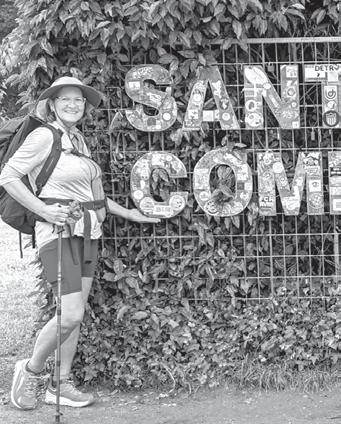
Many choose to walk the journey alone, although the saying goes that you never walk alone.
“The Camino provides,” Price said, quoting another popular saying. “I used that term many times.”


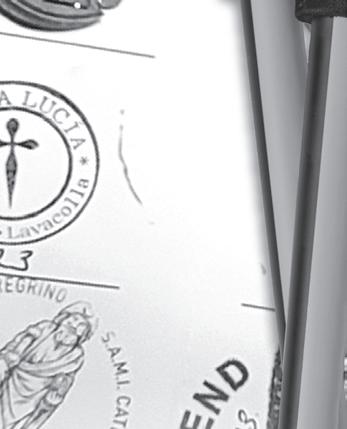


Reasons For The Pilgrimage

To get the Compostela, one must make the pilgrimage for religious or spiritual reasons, or at least an attitude of search.
“It’s a pilgrimage,” Price said. She first read about the walk years ago, and knew she would make the journey herself.
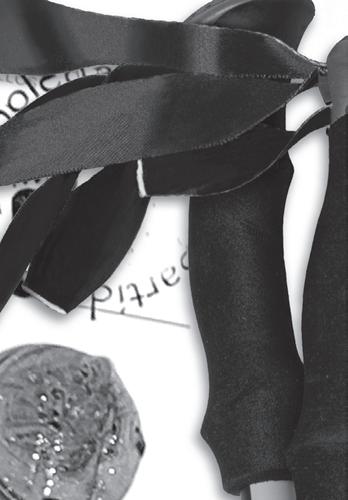
“I just had to do it,” she said. “It was in my heart. It is challenging and rewarding.”
“I went to be outside and walk,” Achatz said. But reading her daily posts on Facebook, it was clear that she spent time on the journey praying and sharing her Christian faith with others.
“I didn’t expect the experience that I had,” she said. “It became very much a spiritual thing for me.”
Five years ago, Price made the walk solo, free to experience the trail on her own terms and timeline. She made friends with dozens of fellow pilgrims, and her sons Joel and Trevor were among those cheering her on from home. Joel tracked her route over the internet and even helped her find her way to a hotel at the start of her journey.
“It was so different walking with somebody,” she said of this year’s trip. Time together and time alone each offered their own rewards.
The French Way
Achatz’s log starts with the trip to Kansas City on April 24 to catch a flight to Charlotte, North Carolina, and then on to Madrid, Spain.
There are several routes for the Camino de Santiago, including some that start outside of Spain. Price and Achatz based their journey on the route known as the French Way, one of the most popular paths, that starts at St. Jean Pied de Port in southwestern France.
They began walking on April 27, a day expected to include seven to eight hours on the trail. It took them more than 11 hours. If someone would have offered them a ride, Achatz said she might have taken them up on it. “But the view was absolutely beautiful and finally a breeze came and cooled us off. I told June I could feel everyone’s prayers.”
The next morning they walked to a local coffee shop for breakfast and continued their journey. “The walk today was absolutely beautiful, felt like we were in a Fairy Tale Forest,” Achatz wrote. The last two hours were the most difficult and when they arrived there were no albergues, so they had to take a taxi to another town and stay in a hotel.
“We don’t want this to happen again so we might take tomorrow off to make reservations for every night hereafter,” she wrote. “When June walked five years ago she didn’t have to do this, so walking the Camino is very popular right now!”
Cost And Other Considerations
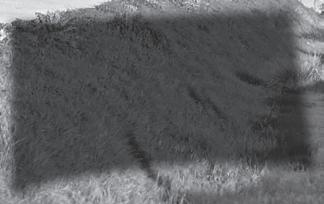
Blisters are a hazard of the walk they experienced but were able to deal with. They each took two pairs of shoes, finding track shoes are better than hiking boots. They carried about 8 pounds of gear in small packs, sending larger backpacks ahead to the albergues.
“You don’t take anything you absolutely don’t have to have, because it’s got to fit in your backpack,” Price said.
One of the most expensive parts of the Camino is the travel to and from Spain. Travel sites say the albergues cost anywhere from 8 euros to 23 euros –usually around 10-11. Currently, 10 euros is equal to about 11 U.S. dollars.

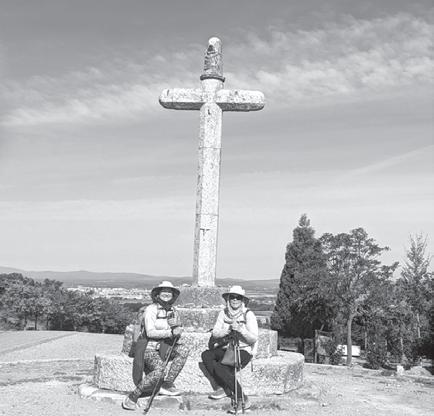
The nicest albergues might have four beds in a room but others had 60 or more beds, sometimes bunked.
“You’re basically paying for a bed and a shower, and then you hand-wash and line dry your clothes, or you can pay to use a machine at some places,” Price said.
Starting Early
The scenery was spectacular, the weather was perfect, and there were always new pilgrims who became friends. Achatz recalled a fun meal with some Australians and a woman from France who didn’t speak English. They took turns typing parts of the conversation into their phones for a translation.

Preparing for a long Day 7 on May 3 (17.9 miles), they woke early and left in the dark at 5:15 a.m., wearing head lamps. Usually they walked closer to 14 miles, sometimes less, arriving at their albergue in the early afternoon. They would take a shower and rest, dining with other pilgrims around 8 in the evening or later, following the Spanish custom.
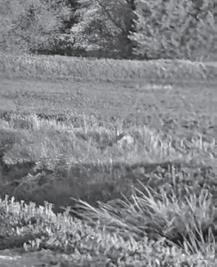

“I thought a lot about my brother Mark today when we passed through an area of shrines of those they were talking for,” Achatz wrote. “I thought about how much he would have loved walking this with me; he loved nature.”
She knew she would follow a pilgrims’ tradition of leaving a rock in Santiago. “‘Because I can’ and he didn’t have the chance, makes me very emotional. So when I leave my rock in Santiago with the name Harmony on it, I’m leaving it in memory of Mark Harmony!”
On Day 21, May 18, she wrote, “The weather has been absolutely beautiful, very cool in the morning and we are taking our jackets off by 10 a.m. We had up and down hills today, nothing bad, WE ARE GETTING STRONGER! We stopped by a really cute cafe for morning coffee and chocolate croissants. I can’t explain the feeling of walking and hearing roosters crow, church bells ringing, birds singing, water flowing — we had it all today! We can see the mountains in the background, which I will be tackling tomorrow and several days after that. June and I are splitting up for the next 13 days. She doesn’t want to do the mountains and I really want to walk and do this. So we will meet in Arca and walk into Santiago together.”
The next day, the two friends hugged and continued their journeys on separate trails. Price said she took a couple of days off and then walked shorter distances so they could meet again the afternoon of May 30.

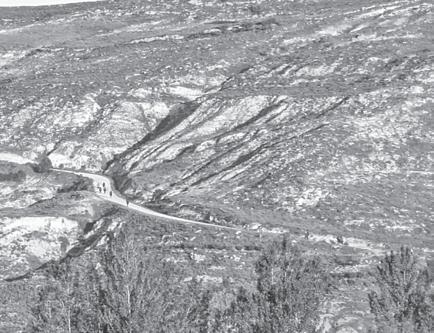
The Final Days
They spent June 1 in Santiago. At 7:30 p.m. Mass they watched the famous Botofumeiro in action. This large censer hangs under the dome inside the Cathedral of Santiago and spreads incense as it swings. It weighs close to 117 pounds and is nearly 5 feet long. Four men stand on either side of the room and pull ropes to keep it swinging.
On June 2 they took a bus to Finisterre, a peninsula on the west coast of Spain, sharing a taxi with another pilgrim couple so they could watch the sunset from a lighthouse. The name “Finisterre” means “Land’s End” in Latin and the 2.4 mile walk from the town to the cape was considered the End of the World in medieval times.
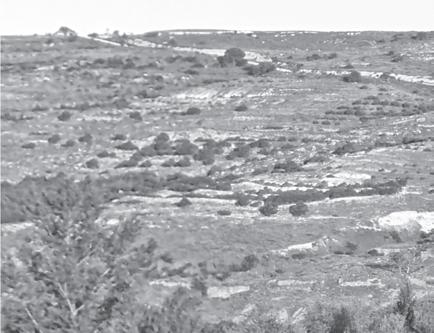
“It was very moving and that is where I have decided to leave my rock,” Achatz wrote. She placed her “Harmony” stone near a cross and stopped to pray at the end of the earth in Spain.
Price also left a stone at Finisterre. Five years ago, she’d carried a rock on which she’d painted the names of her late family members. She threw that stone into the ocean.

This time, since her sister had passed away, there was one more name painted on her stone. “I tucked it between the gap in the stones in a building that overlooked the ocean,” she said. “If I do go back someday, I know exactly where that little stone is.”
Writing her blog entry that night, Achatz thought of the things she would miss when she returned home: Walking beautiful trails, stopping in villages and drinking coffee con leche, hearing people’s stories.
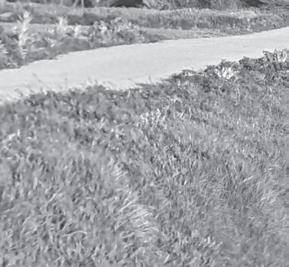
“But what I look forward to is kissing my husband, hugging my children and grandchildren, understanding what is on a menu at a restaurant, a normal towel after a shower, my own bed and pillow, the simple things in life!” she wrote.
“I’ve had the best of both; walking with a friend and walking by myself, both have been wonderful.”
“It’s challenging and rewarding,” Price agreed.












